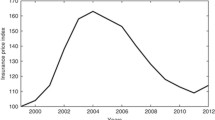Abstract
This paper analyzes the welfare effects of the recently revised Italian corporate law, that allows limited liability companies (so called società a responsabilità limitata) to replace the fulfillment of strict capital requirements with the subscription of insurancecontracts that make capital available in case of default. We find that such insurance contracts are not convenient for insurers. However, if a benevolent planner is willing to subsidize insurers' expected losses, these contracts turn out to be welfare improving for a wide range of the relevantparameters. By calibrating the model with Italian data, we find that social welfare is maximized when the premium charged by the subsidized insurance companies is about 10% of total capitalrequirements; moreover, in this case the planner faces negligible expected losses.
Similar content being viewed by others
References
AA.VV. (Company Law Working Group), (1999). “Recommendations on the simplification of the first and second company law directives.”
AA.VV. (High Level Group of Company Law Experts), (2002). “A modern regulatory framework for company law in europe: A consultative document of high level group of company experts.”
AA.VV. (Commissione per la Riforma del Diritto Societario), (2002). “Relazione della commissione per la riforma del diritto societario.”
Capitalia. (2003). “Indagine sulle imprese manifatturiere, 2003”.
Denozza, F. (2003). “A Che Serve il Capitale?.” Mimeo.
Enriques, L. & Macey, J. R. (2001). “Creditors Versus Capital Formation: The Case Against the European Capital Rules.” Cornell Law Review.
Evans, D. S. & Jovanovic, B. (1989). “An Estimated Model of Entrepreneurial Choices Under Liquidity Constraints.” Journal of Political Economy.
Fazzari, S. et al. (1988). “Investment and Financing Reconsidered.” Brookings Papers on Economic Activity.
Jensen, M. & Meckling, W. (1976). “Theory of the Firm: Managerial Behavior, Agency Costs and Ownership Structure.” Journal of Financial Economics.
Holtz-Eakin, D. et al. (1994). “Sticking It Out: Entrepreneurial Survival and Liquidity Constraints.” Journal of Political Economy.
Myers, S. & Majluf, N. (1984). “Corporate Financing and Investment Decisions When Firms Have Information That Investors Do Not Have.” Journal of Financial Economics.
Pernazza, F. & Spallone, M. (2003). “Incentives to Entrepreneurs in the Revised Italian Corporate Law.” Mimeo.
Rothschild, M. & Stiglitz, J. (1976). “Equilibrium in Competitive Insurance Markets: An Essay on the Economics of Imperfect Information”. Quarterly Journal of Economics.
Spence, A.M. (1976). “Job Market Signaling.” Quarterly Journal of Economics.
Author information
Authors and Affiliations
Corresponding author
Additional information
JEL Classification: D21, G32, H25, K22
Rights and permissions
About this article
Cite this article
Casagrande, A., Spallone, M. Relaxing Liquidity Constraints for Start-Ups: A Welfare Analysis Over the Italian Revised Corporate Law. Eur J Law Econ 20, 339–357 (2005). https://doi.org/10.1007/s10657-005-4200-1
Issue Date:
DOI: https://doi.org/10.1007/s10657-005-4200-1




